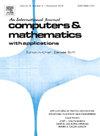Energy-preserving RERK-FEM for the regularized logarithmic Schrödinger equation
IF 2.5
2区 数学
Q1 MATHEMATICS, APPLIED
引用次数: 0
Abstract
A high-order implicit–explicit (IMEX) finite element method with energy conservation is constructed to solve the regularized logarithmic Schrödinger equation (RLogSE) with a periodic boundary condition. The discrete scheme consists of the relaxation-extrapolated Runge–Kutta (RERK) method in the temporal direction and the finite element method in the spatial direction. Choosing a proper relaxation parameter for the RERK method is the key technique for energy conservation. The optimal error estimates in the -norm and -norm are provided without any restrictions between time step size τ and mesh size h by temporal–spatial splitting technology. Numerical examples are given to demonstrate the theoretical results.
正则对数Schrödinger方程的能量守恒rk - fem
针对具有周期边界条件的正则对数Schrödinger方程(RLogSE),构造了一种具有能量守恒的高阶隐显有限元方法。离散格式包括时间方向上的松弛外推龙格-库塔(RERK)法和空间方向上的有限元法。选择合适的松弛参数是实现能量守恒的关键技术。利用时空分割技术,在不受时间步长τ和网格尺寸h限制的情况下,给出了l2范数和h1范数的最优误差估计。数值算例验证了理论结果。
本文章由计算机程序翻译,如有差异,请以英文原文为准。
求助全文
约1分钟内获得全文
求助全文
来源期刊

Computers & Mathematics with Applications
工程技术-计算机:跨学科应用
CiteScore
5.10
自引率
10.30%
发文量
396
审稿时长
9.9 weeks
期刊介绍:
Computers & Mathematics with Applications provides a medium of exchange for those engaged in fields contributing to building successful simulations for science and engineering using Partial Differential Equations (PDEs).
 求助内容:
求助内容: 应助结果提醒方式:
应助结果提醒方式:


